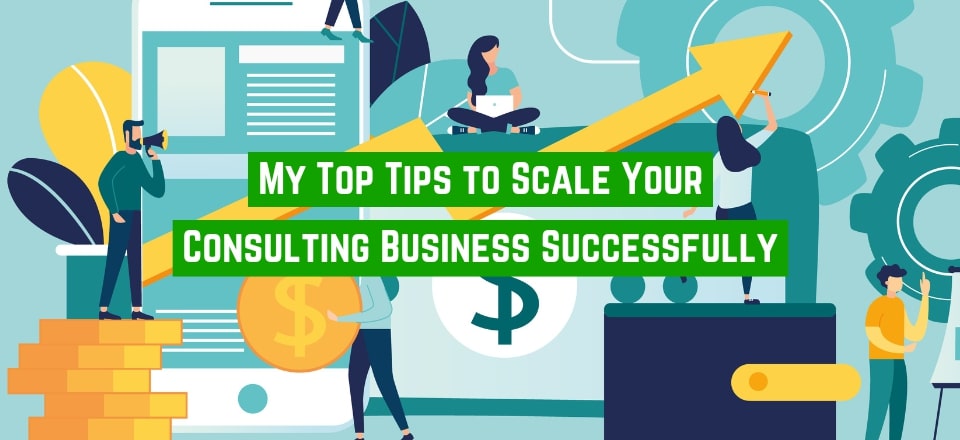
As an independent business or management consultant, there may come a time when you want your business to comprise more than just you. So how do you affect the growth you wish for and scale your business from a one-man-outfit to a substantial enterprise?
Well, that’s what I’m going to cover in this article.
It’s a good idea to break a scaling strategy down into three distinct stages, and I want to walk you through those briefly, to give you some food for thought and help you develop your plans for business growth.
Start With Your Five-Year Vision

Now, you might not be planning on scaling. After all, there’s no harm in continuing on your own and happily servicing your clients, although that’s a little more like contracting.
But if you plan to grow your consulting business, there are some distinct phases that you need to go through, and you will need to consider your options for resourcing. I will explain these phases and outline how I’ve applied them in my consulting business over the last 25 years.
When my former business partner and I launched what later became my consulting business, it was just the two of us. But we sat down and drew out the organisational structure we wanted to see five years later. So we dug it out after about seven years. And funnily enough, our structure was set out precisely per the plan we had drawn up.
Chart Your Structure for Now, and for the Future
Why is it important to establish your org structure early? Because you need to visualise what you expect your business to look like when it eventually scales. And that initial organisation chart, guess what? It had two names and all the boxes, you know.

So I was MDA, CFO, and project delivery. And my partner had several boxes with his name in them. So we envisaged how it was going to look. Initially, our names were in all the boxes. And then, gradually, other people’s names went into those boxes over the years.
So develop that view of what the business will look like and determine your end goal.
But what about these three phases that I’ve mentioned?
The First Phase: Increase Your Capacity to Serve
I’ve discussed this a few times in other posts and videos. Your focus initially has got to be on service delivery. You know, delivering excellent outcomes for your clients, growing your client base, growing your client accounts, and so on.
As you scale, you’re going to need more consultants. And that’s a continual process throughout the life of your consulting business, to be honest. There are a couple of ways you can do that.
If you are, you know, bootstrapping your consulting business—in other words, you’re funding it yourself from cash flow, you want to try and minimize the cash outlay.
One option is to hire contractors initially to help you, and then you can transition those to employees later if that suits you. That’s certainly something I did in the early days. And then, gradually, you can build your team like that.

You’ve got to bolster your capability to deliver a greater volume of services if you’re going to grow your business. That’s generally the first critical phase.
The Second Phase: Hands off the Back Office
The second phase as the business owner is to wean yourself away from the back office and stop executing non-value-adding tasks.

I don’t mean to be derogatory about accountants or anything, but the lifeblood of a consulting business is sales and service delivery. Those are the factors that ensure business survival, and in many cases, the founder of the enterprise has considerable strength in these disciplines. That’s why you must seek and hire experts in the back office functions to whom you can delegate.
As regards admin, when I started 25 years ago, I took on a part-time bookkeeper, but I was doing all the client invoicing and things like that. Later I replaced the part-time position with a full-time accountant, and gradually my admin team grew.
I started by outsourcing back-office tasks, in effect, using contractors, and then the in-house employee team grew and grew and grew. Now I have a back office staff of about 15 people.
The key message I’m sharing is that you should build your back-office team over time, enabling you to detach yourself more and more from the administrative side and focus on sales, service delivery, and setting out on the third growth phase—increasing your marketing capability.
The Third Phase: Build Your Marketing Team
When I started my business 25 years ago, marketing was hard. It was expensive. It involved a lot of print advertising. Today it’s so much more accessible online, and you can be very cost-effective.

Ideally, it makes sense to start growing your marketing team in parallel with increasing the strength of your admin team. And again, you can outsource that initially.
However, for my money, outsourced marketing is only a short-term solution. I want more control and input into marketing than outsourcing allows, but it’s undoubtedly an excellent way to start. So outsource it, and have some contractors helping you, but then you want to be building your in-house team as well.
I won’t tell you how big our marketing team is. You would be flabbergasted. Our marketing team is the size of a business ten times our scale. That’s because:
1) I love marketing. It’s a passion of mine.
2) I know how to make marketing work, and when I invest anything in my business, it tends to be more into marketing.
The Three-Legged Stool

It can help to think of your scaling strategy as a three-legged stool. You know, you’ve got the delivery services. You’ve got the admin. You’ve got the marketing.
That’s how I grew my business. I started 25 years ago with just two of us, the two founders. We did all the service delivery, sales, admin, and marketing. But gradually, over time, we’ve built a team that now stands at 50 or 60 people. It’s a strategy that works. We proved it!
What Are Your Thoughts on Scaling Up?
To conclude this post, let me ask you a question. What size is your consulting business’ headcount now, and what do you plan it to be?

I’m curious to see how many of you reading this are happy to be, you know, just one or two consultants, or have you got grand plans to grow to a hundred, a thousand, or whatever?
We’d love to see your comments below. Your feedback helps us gear our posts to cover the topics you want to digest. And if you’d like some help to resource your business growth, we’re always ready to set you up with one (or more) of our virtual assistants, to whom you can delegate those back-office tasks mentioned above. Please get in touch with us to learn more about that.
Some of our posts, like this one, are based on videos created and presented by Rob O’ Byrne on the Consulting Business School YouTube channel. So why not take a look at the video?
If you’re not yet subscribed to the channel, do it now, before you forget, so you can stay up to date with all the helpful consulting guidance that Rob’s team regularly posts there.



Recent Comments